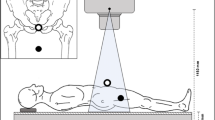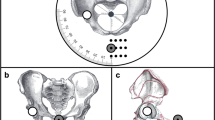Abstract
Background
Radiostereometric Analysis (RSA) is used to measure fixation of joint prosthesis. This study compared radiation dose and image quality of a digital radiography (DR) RSA system and a computed radiography (CR) RSA system in a clinical setting.
Methods
RSA recordings of 24 hips and shoulders were analyzed. We compared two systems: (1) Arcoma T0 with ST-VI image plates and Profect CR-IR 363 reader to (2) AdoraRSA with CXDI-70C wireless DR detectors in a clinical uniplanar RSA set-up with a ± 20 degrees tube angulation and 35 cm × 43 cm detectors. Effective dose was calculated using dedicated software. Image quality was evaluated using calibration errors as calculated by the RSA software.
Results
The mean dose for hips was 0.14 (SD 0.04) mSv in the CR system and 0.05 (SD 0.02) mSv in the DR system. The mean dose for shoulders was 0.16 (SD 0.07) mSv in the CR system and 0.09 (SD 0.03) mSv in the DR system. Radiation dose was 64% (p < 0.001) and 43% (p = 0.03) lower in the DR system compared with the CR system for hip and shoulder RSA, respectively. Image quality was better for the DR system with 60–80% less calibration errors compared to the CR system.
Conclusion
Owing to highly efficient detectors and added filtration at the x-ray tubes, the DR system considerably reduced radiation dose compared with the CR system without compromising image quality.
Based on the findings in this study, we recommend replacing CR RSA systems with DR RSA systems.
Registration
Patients were selected from clinical studies performed on the two systems and approved by the local ethics committee [20060165, M-20100112, M-20070082, M-20110224, and 20070258] and registered with ClinicalTrials.gov [NCT00408096, NCT01289834, NCT00913679, NCT02311179, and NCT00679120].





Similar content being viewed by others
Availability of data and materials
Due to GDPR and the sensitive nature of x-rays, sharing of raw data is not possible. However, we will try to accommodate any reasonable request for sharing anonymized data.
References
Selvik G (1989) Roentgen stereophotogrammetry. A method for the study of the kinematics of the skeletal system. Acta Orthop Scand Suppl 232:1–51. https://doi.org/10.3109/17453678909154184
Valstar ER, Nelissen RGHH, Reiber JHC, Rozing PM (2002) The use of Roentgen stereophotogrammetry to study micromotion of orthopaedic implants. ISPRS J Photogramm Remote Sens 56:376–389. https://doi.org/10.1016/s0924-2716(02)00064-3
Kaptein BL, Valstar ER, Stoel BC, Rozing PM, Reiber JHC (2003) A new model-based RSA method validated using CAD models and models from reversed engineering. J Biomech 36:873–882. https://doi.org/10.1016/s0021-9290(03)00002-2
Karrholm J, Gill RH, Valstar ER (2006) The history and future of radiostereometric analysis. Clin Orthop Relat Res 448:10–21. https://doi.org/10.1097/01.blo.0000224001.95141.fe
Korner M, Weber CH, Wirth S et al (2007) Advances in digital radiography: physical principles and system overview. Radiographics 27:675–686. https://doi.org/10.1148/rg.273065075
Neitzel U (2005) Status and prospects of digital detector technology for CR and DR. Radiat Prot Dosimetry 114:32–38. https://doi.org/10.1093/rpd/nch532
Teeuwisse W BR, Geleijns J (1998) Stralenbelasting bij orthopedische radiologie n.d. Gamma:3.
Blom IF, Koster LA, Brinke BT, Mathijssen NMC (2020) Effective radiation dose in radiostereometric analysis of the hip. Acta Orthop 91:390–395. https://doi.org/10.1080/17453674.2020.1767443
Lindgren LJP, Mørup RMS, Jensen M, Rømer L, Kaptein B, Stilling M (2019) Similar patient positioning: A key factor in follow-up studies when using model-based radiostereometric analysis of the hip. Radiography. https://doi.org/10.1016/j.radi.2019.10.009.10.1016/j.radi.2019.10.009
Tapiovaara M, Siiskonen T (2008) A PC-based Monte Carlo program for calculating patient doses in medical x-ray examinations.
Duda RO, Hart PE (1972) Use of the Hough transformation to detect lines and curves in pictures. Commun ACM 15:11–15. https://doi.org/10.1145/361237.361242
Vrooman HA, Valstar ER, Brand GJ et al (1998) Fast and accurate automated measurements in digitized stereophotogrammetric radiographs. J Biomech 31:491–498. https://doi.org/10.1016/s0021-9290(98)00025-6
Shetty CM, Barthur A, Kambadakone A, Narayanan N, Kv R (2011) Computed radiography image artifacts revisited. AJR Am J Roentgenol 196:W37-47. https://doi.org/10.2214/AJR.10.5563
Funding
The study was performed under the Innovation Fund Denmark Grant 69–2013-1 “Transforming radiological technology for assessment of implant fixation: from research tool to clinical application”. None of the authors report any conflicts of interest.
Author information
Authors and Affiliations
Contributions
PBJ, NKN, BK and MS designed and wrote the manuscript, and RMSM performed the image analyses. All contributed to the data interpretation and critical revision of the manuscript.
Corresponding author
Ethics declarations
Competing interests
Financial interests: The authors declare they have no financial interests. Non-financial interests: Authors Bart Kaptein and Maiken Stilling are on the board of The International Radiostereometry Society.
Ethics approval and consent to participate
Patients were selected from clinical studies performed on the two systems and approved by the local ethics committee [20060165, M-20100112, M-20070082, M-20110224, and 20070258] and registered with ClinicalTrials.gov [NCT00408096, NCT01289834, NCT00913679, NCT02311179, and NCT00679120].
Consent for publication
Not applicable.
Additional information
Publisher's Note
Springer Nature remains neutral with regard to jurisdictional claims in published maps and institutional affiliations.
Supplementary Information
Below is the link to the electronic supplementary material.
Rights and permissions
Springer Nature or its licensor (e.g. a society or other partner) holds exclusive rights to this article under a publishing agreement with the author(s) or other rightsholder(s); author self-archiving of the accepted manuscript version of this article is solely governed by the terms of such publishing agreement and applicable law.
About this article
Cite this article
Jørgensen, P.B., Krag-Nielsen, N., Lindgren, L. et al. Radiostereometric analysis: comparison of radiation dose and precision in digital and computed radiography. Arch Orthop Trauma Surg 143, 5919–5926 (2023). https://doi.org/10.1007/s00402-022-04674-0
Received:
Accepted:
Published:
Issue Date:
DOI: https://doi.org/10.1007/s00402-022-04674-0




